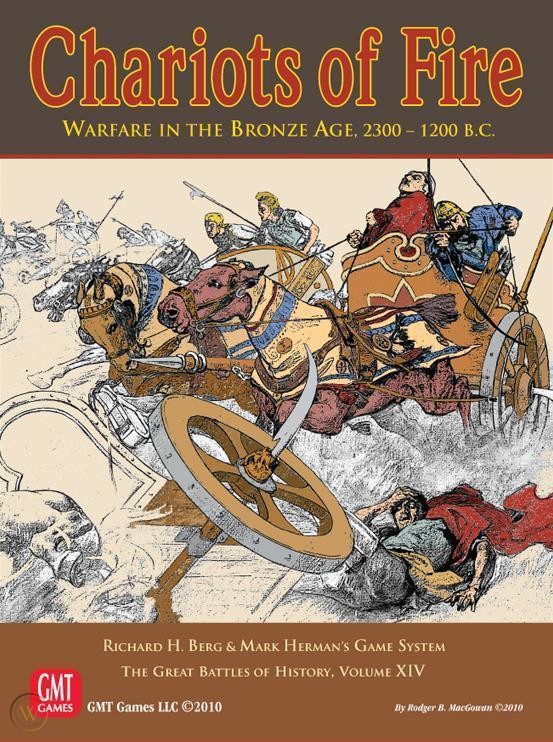
The Great Battles of History series ventures back into the mists of time: the Bronze Age, or the Age of the Chariot. From approximately 1700 BC to 1200 BC (which was the abrupt end of the Bronze Age) the chariot reigned supreme on the battlefield. It was the first modern weapons system, and chariots controlled most of warfare until actual cavalry appeared in the middle of the Iron Age.
But how did chariots work as a tactical weapons system? There is no complete historical agreement on what exactly they did or how they were used, but Chariots of Fire will show you our view of their many applications – and many types of chariotry there were – providing GBoH players with the complete and definitive chariot rules. These rules cover combat and mobility from the first battle wagons of the Sumerians to the two-man, fast-moving light chariots of the Egyptians, often complete with their associated and specialized Runner Infantry, to the heavy 3-man Hittite wheels.
Egypt (XVIIIth Dynasty), under Pharaoh Thutmose III vs. the Mitanni under King Barattarna The Naharin Bend of the Upper Euphrates River, Mesopotamia, ca. 1470 BC
The Annals’ reference to Thutmose having “overthrown” Kadesh is probably to his defeat of Kadesh’s maryanna and not to his having captured the city itself. had Kadesh been taken, it could have been taken only by siege, and there is no mention of one having occurred. If we can trust Amenemhab once more, Thutmose moved north toward Tunip and Qatna almost immediately after the skirmish at Kadesh, thereby making it very unlikely that he took Kadesh under siege. moreover, the capture of Kadesh would have been an enormous victory and would have merited much more extensive narration in the Annals than it received. The tribute lists would also have reflected much greater quantities of booty than they do. The capture of Kadesh would have certainly resulted in the transfer of its “vile prince” to Egypt amid great fanfare, and some record of his execution would almost certainly exist. Nevertheless, Thutmose had still been able to demonstrate that the main perpetrator of Egypt’s troubles in Syria was no longer beyond the Egyptian army’s operational reach.
What followed suggests that intimidation, not conquest, was the purpose of Thutmose’s march into the Syrian interior. having made his point at Kadesh, Thutmose turned north and marched up the Orontes. The Annals tell us that he “came to the land of Senzar.” Senzar is probably the Zinzar of the Amarna texts and is located on the Orontes close to modern Hamah. The march took him through the territories of the powerful city-states of Qatna and Tunip, and Thutmose put on a dramatic demonstration of Egyptian military might and his willingness to confront the Syrian cities on their own ground. Thutmose was playing a psychological game.
After Thutmose III had taken control of the Syrian cities, the obvious target for his eighth campaign was the state of Mitanni. However, to reach Mitanni, he had to cross the Euphrates river. Therefore, Thutmose III sailed directly to Byblos and then made boats which he took with him over land on what appeared to otherwise be just another tour of Syria. He proceeded with the usual raiding and pillaging as he moved north through the lands he had already taken. However, here he continued north through the territory belonging to the still unconquered cities of Aleppo and Carchemish, and then quickly crossed the Euphrates in his boats, taking the Mitannian king, Barattarna, entirely by surprise. It appears that Mitanni was not expecting an invasion, so they had no army of any kind ready to defend against Thutmose. The Egyptian victory was total, and Thutmose had extended Egypt’s empire to its farthest historical sphere.